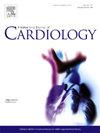Impact of radiofrequency versus cryoballoon ablation on left atrial calcification after atrial fibrillation ablation: A propensity score-matched comparison
IF 3.2
2区 医学
Q2 CARDIAC & CARDIOVASCULAR SYSTEMS
引用次数: 0
Abstract
Introduction
Left atrial calcification (LAC) following atrial fibrillation (AF) ablation is associated with major adverse cardiovascular events, with prior reports focusing on radiofrequency catheter ablation (RFCA) rather than cryoballoon ablation (CBA). The aim of this study was to investigate the frequency of LAC and stiff LA physiology (SLAP) in patients undergoing CBA as the initial therapy for AF, compared with those undergoing RFCA, using a propensity score-matched (PSM) population.
Methods
We conducted a retrospective cohort study involving 2680 consecutive patients who underwent AF ablation with RFCA or CBA. Patients with rheumatic valve disease or mitral valve replacement, those undergoing dialysis, and those without postoperative computed tomography (CT) imaging were excluded. CT images acquired ≥1 year after the initial procedure were used to evaluate the LAC.
Results
In total, 473 eligible patients were identified. PSM created 125 pairs. After a median follow-up of 4.7 years, 9 (4 %) of 250 patients presented with LAC. Those who underwent CBA had a significantly lower incidence of LAC and SLAP compared to those who underwent RFCA (LAC: 1 % vs. 6 %, P = 0.03; SLAP: 1 % vs. 9 %, P = 0.005). Right ventricular systolic pressure significantly increased in the RFCA group (pre-ablation: 23 ± 8 vs. post-ablation: 26 ± 8, P = 0.01), but remained unchanged in the CBA group (pre-ablation: 23 ± 7 vs. post-ablation: 23 ± 8, P = 0.88).
Conclusions
The use of CBA as the initial ablation seems to have clinical benefits in preventing LAC and SLAP compared to RFCA.

求助全文
约1分钟内获得全文
求助全文
来源期刊

International journal of cardiology
医学-心血管系统
CiteScore
6.80
自引率
5.70%
发文量
758
审稿时长
44 days
期刊介绍:
The International Journal of Cardiology is devoted to cardiology in the broadest sense. Both basic research and clinical papers can be submitted. The journal serves the interest of both practicing clinicians and researchers.
In addition to original papers, we are launching a range of new manuscript types, including Consensus and Position Papers, Systematic Reviews, Meta-analyses, and Short communications. Case reports are no longer acceptable. Controversial techniques, issues on health policy and social medicine are discussed and serve as useful tools for encouraging debate.
 求助内容:
求助内容: 应助结果提醒方式:
应助结果提醒方式:


